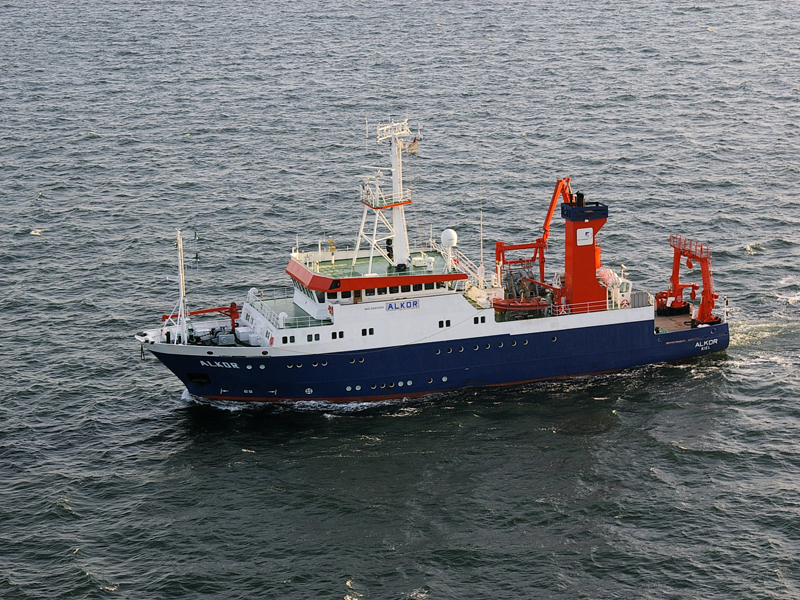ALKOR AL346
- Area:
- Baltic Sea, Gotland Basin
- Time:
-
18.09.2009 - 05.10.2009
- Institution:
- IFM-GEOMAR
- Chief scientist:
- Olaf Pfannkuche
Cruise-description (short version)
ALKOR 346: First IFM-GEOMAR - HYPOX expedition to the Gotland Basin underway.
From 18. Sept to 6 Oct. R/V ALKOR is working in the eastern Gotland Basin (central Baltic Sea.). The cruise led by R. Olaf Pfannkuche, is carried out within the framework of the new FP-7 project “HYPOX” (In situ monitoring of oxygen depletion in hypoxic ecosystems of coastal and open seas, and land-locked water bodies, www.hypox.net/). Besides IFM-GEOMAR scientists researchers from Sweden and Denmark participate in the expedition.
A major focus of this cruise is on in situ measurements of turnover and fluxes of nitrogen compounds, phosphate, iron, manganese and carbon in the benthic boundary layer at variable oxygen concentrations of the bottom water. In parallel to these measurements of the natural environment, the effects of variable oxygen availability (thresholds) in the bottom water on N-speciation and release of nutrients shall be determined by additional in situ experiments. Further activities of this cruise comprise biological investigations (meiobenthos, epibenthos) and sea floor imaging
Severe envirnonmental problems
The Baltic Sea is the largest brackish water basin in the world after the Black Sea. Since the residence time of the water in the Baltic Sea is as long as 25-35 years, and the average depth is not more than about 60 m, sediments play an essential role in the biogeochemical cycles of nutrient elements and carbon in the Baltic Sea system. The Baltic Sea is a marine system with severe environmental problems. Oxygen is depleted at 90-110 m depth (Figure) and the area of anoxic bottoms is at present around 45 000 km2.
The water body of central Baltic is distinctively stratified. A permanent halocline at appr.60-80m water depth prevents vertical mixing between the almost homo-haline surface water and the deeper water masses of higher salinity. A seasonal thermocline develops in the summer months in the surface water body producing an intense stratification.The Gotland Basin is a flat basin with gentle slopes with a maximum depth of 249m that displays almost permanently anoxic conditions in its deepest parts. Annual sedimentation rates in the central Gotland Basin are estimated to 1.0-1.3mm/yr. Values on the slopes are lower and re-suspension occasionally occurs which can cause lateral transport of suspended materials. The Holocene muds exhibit a high concentration of organic matter (10-15% dry weight). The surface sediments of the area of investigation are soft, black organic rich and of high porosity.
Massive summer blooms of cyanobacteria
Massive summer blooms of cyanobacteria in surface waters of the Baltic Sea are well known. They can be toxic and have been plaguing the Baltic proper since many years influencing e.g. the recreational value of the coast and hence tourism. The cyanobacteria summer bloom in 2005 was greater than the preceding spring bloom in terms of P-uptake. Roughly 0.5 million tons N is imported to the Baltic Sea annually through pelagic cyanobacterial N2-fixation. It is believed that internal sources (P-mobilization from sediments) and sinks (denitrification in sediment and suboxic/anoxic water) in the Baltic proper are causing N/P ratios in the water column that are lower than the Redfield ratio. This is a prerequisite for cyanobacteria summer blooms.
ALKOR Cruise 346
The overall objective of Cruise AL 346 is to understand the role of open sea sediments of the Baltic Proper under low oxic to anoxic conditions as sources and sinks for nitrogen, phosphorus, trace metals and carbon. Major working sites will be in the eastern Gotland Basin of the Baltic Proper along three depth transect lines. The transect lines include 8 stations, which have been visited during a pre-study with R/V Poseidon (POS 369. July-August 2008) and a Swedish cruise with RV Skagerak (September 2008). These stations, ranging from shallow water (~ 67 m) to deep water (~219 m), are representative for the Gotland Basin and include sites with both oxygenated and anoxic bottom water. Stations are selected so that the major bottom types, are included. Coarse-grained erosional bottoms are not relevant for the present project.
In situ measurements and experiments in benthic mesocosms deployed with lander systems are a prominent feature of the cruise. 3 Lander of the GEOMAR—Type and two lander of the UGOT-type will be in operation . Other major gear operated are: a TV-guided multicorer, a towed benthic camera observation system and a CTD/Rosette-watersampler.



